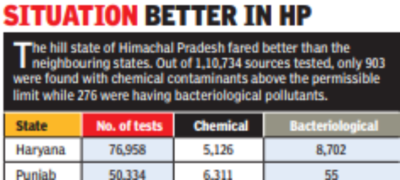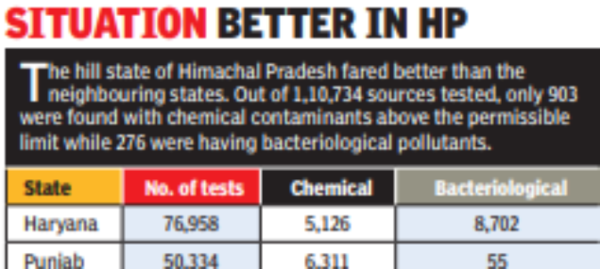Top Searches
- News
- City News
- chandigarh News
- 16% water samples failed test in Punjab and Haryana in 2022
16% water samples failed test in Punjab and Haryana in 2022

Nearly 16% of water samples tested during the year were found not fit for drinking in Punjab and Haryana. Bacteriological contamination of water, a major contributor to water-borne diseases in rural areas, was high in Haryana while the majority of samples which failed the test in Punjab had chemical contamination.
CHANDIGARH: Nearly 16% of water samples tested during the year were found not fit for drinking in Punjab and Haryana. Bacteriological contamination of water, a major contributor to water-borne diseases in rural areas, was high in Haryana while the majority of samples which failed the test in Punjab had chemical contamination.
As contaminated water poses a great health hazard, the state governments have to carry out testing of drinking water sources for chemical and physical parameters for bacteriological parameters.

As per the testing data of Jal Jeevan Mission till December 30, 1,27,292 samples - 76,958 from Haryana and 50,334 from Punjab - collected from rural water supply sources, delivery points and public/private water bodies were examined, of which 20,194 (15.86%) - 13,828 from Haryana and 6,366 from Punjab - were found to be polluted.
Of the total samples found contaminated in Haryana, 5,126 had the presence of arsenic (As) and mercury (Hg) uranium (U) above the permissible limits. Long-term exposure to these chemicals, especially arsenic in drinking water, can have harmful health effects as it increases the risk of skin, lung, bladder and kidney cancer. Bacteriological contamination was found on the higher side in 8,702 samples. Bacteriological contamination may contain pathogens that can cause diarrhoea, vomiting, cramps, nausea, headaches, fever and fatigue.
The district-wise analysis of the data showed that the maximum number of samples failed in Bhiwani, where 1,921 samples were found to be having higher levels of bacteriological pollutants and 639 had high presence of chemicals. As many as 1,324 samples failed the test in Sonipat, 1,096 in Gurugram, 969 in Jind and 929 in Mahendragarh.
In Punjab, 6,311 samples had chemical contamination while 55 samples were found to be having bacteriological levels. Amritsar had the maximum 1,065 samples which failed the test followed by 811 in Patiala, 718 in Gurdaspur, 705 in Ropar and 489 in Hoshiarpur.
There are 18 districts in Haryana which are partly affected by salinity, iron and nitrate contaminants in groundwater. The count of such districts stands at 12 in Punjab. Few pockets in 21 districts of Haryana have nitrate more than the permissible limit of 45mg/l in groundwater and iron above 1mg/l in parts of 20 districts. Similarly, in Punjab, all the districts have few pockets where the nitrate level is higher.
To address the problem of water contamination, the central government in association with the state government is making provision for providing potable tap water supply in adequate quantity of prescribed quality on a regular and long-term basis to every rural household by 2024. Priority is being given to quality-affected habitations.
As contaminated water poses a great health hazard, the state governments have to carry out testing of drinking water sources for chemical and physical parameters for bacteriological parameters.

As per the testing data of Jal Jeevan Mission till December 30, 1,27,292 samples - 76,958 from Haryana and 50,334 from Punjab - collected from rural water supply sources, delivery points and public/private water bodies were examined, of which 20,194 (15.86%) - 13,828 from Haryana and 6,366 from Punjab - were found to be polluted.
Of the total samples found contaminated in Haryana, 5,126 had the presence of arsenic (As) and mercury (Hg) uranium (U) above the permissible limits. Long-term exposure to these chemicals, especially arsenic in drinking water, can have harmful health effects as it increases the risk of skin, lung, bladder and kidney cancer. Bacteriological contamination was found on the higher side in 8,702 samples. Bacteriological contamination may contain pathogens that can cause diarrhoea, vomiting, cramps, nausea, headaches, fever and fatigue.
The district-wise analysis of the data showed that the maximum number of samples failed in Bhiwani, where 1,921 samples were found to be having higher levels of bacteriological pollutants and 639 had high presence of chemicals. As many as 1,324 samples failed the test in Sonipat, 1,096 in Gurugram, 969 in Jind and 929 in Mahendragarh.
In Punjab, 6,311 samples had chemical contamination while 55 samples were found to be having bacteriological levels. Amritsar had the maximum 1,065 samples which failed the test followed by 811 in Patiala, 718 in Gurdaspur, 705 in Ropar and 489 in Hoshiarpur.
There are 18 districts in Haryana which are partly affected by salinity, iron and nitrate contaminants in groundwater. The count of such districts stands at 12 in Punjab. Few pockets in 21 districts of Haryana have nitrate more than the permissible limit of 45mg/l in groundwater and iron above 1mg/l in parts of 20 districts. Similarly, in Punjab, all the districts have few pockets where the nitrate level is higher.
To address the problem of water contamination, the central government in association with the state government is making provision for providing potable tap water supply in adequate quantity of prescribed quality on a regular and long-term basis to every rural household by 2024. Priority is being given to quality-affected habitations.
About the Author
Vinod KumarVinod Kumar is with The Times of India’s Punjab Bureau at Chandigarh. He covers news concerning Punjab politics, Health, Education, Employment and Environment.
Start a Conversation
FOLLOW US ON SOCIAL MEDIA
FacebookTwitterInstagramKOO APPYOUTUBE









